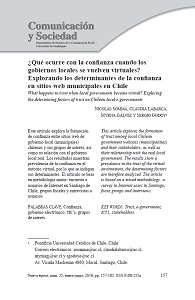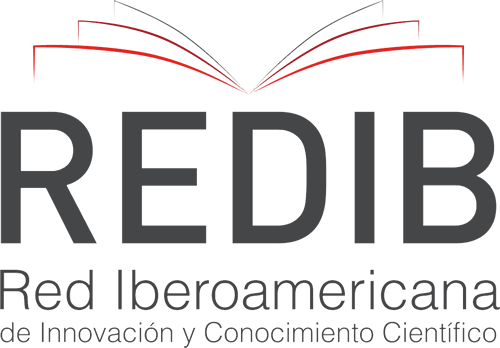¿Qué ocurre con la confianza cuando los gobiernos locales se vuelven virtuales? Explorando los determinantes de la confianza en sitios web municipales en Chile
DOI:
https://doi.org/10.32870/cys.v0i25.4425Palabras clave:
Confianza, gobierno electrónico, TIC’s, grupos de interésResumen
Este artículo explora la formación de confianza entre sitios web de gobierno local (municipales) chilenos y sus grupos de interés, así como su relación con el gobierno local real. Los resultados muestran prevalencia de la confianza en el entorno virtual, por lo que se indagan sus determinantes. El artículo se basa en metodología mixta: encuesta a usuarios de Internet en Santiago de Chile, grupos focales y entrevistas a usuarios.Descargas
Citas
Allison, P. (1999). Multiple regression: A primer. ca, ee.uu.: Pine Forge Press.
Angell, A. (1997). Reforma educativa y política en Chile. Perfiles Latinoamericanos, 10, 9-34. Recuperado el 20 de diciembre de 2013 de http://www.redalyc.org/pdf/115/11501002.pdf.
Argenti, P. (2009). Corporate communication. Nueva York, ee.uu.: McGraw Hill.
Bannister, F. & Connolly, R. (2011). Trust and transformational government: A proposed framework for research. Government Information Quarterly, 28 (2911), 137-147.
Belanger, F. & Carter, L. (2008). Trust and risk in e-government adoption. The Journal of Strategic Information Systems, 17 (2), 165-176.
Beldad, A., De Jong, M. & Steehouder, M. (2010). How shall I trust the faceless and the intangible? A literature review on the antecedents of online trust. Computers in Human Behavior, 26 (5), 857-869.
Boon, S. & Holmes, J. (1991). The dynamics of interpersonal trust: Resolving uncertainty in the face of risk. En R. A. Hinde & J. Groebel (Eds.), Cooperation and prosocial behavior (pp. 190-211). Cam-bridge, Inglaterra: Cambridge University Press.
Brady, H. E., Verba, S. & Schlozman, K. L. (1995). Beyond ses: A resource model of political participation. American Political Science Review, 89 (2), 271-294.
Butler, J. (1999). Trust expectations, information sharing, climate of trust, and negotiation effectiveness and efficiency. Group & Organization Management, 24, 217-238.
Calderón, C. (2011). La imagen es la identidad. Santiago de Chile, Chile: eBooks Patagonia.
Calderón, F. (2012). Diez tesis sobre el conflicto social en América Latina. Revista Cepal, 107. Recuperado el 3 de enero de 2014 de http:// www.eclac.cl/publicaciones/xml/8/47598/RVE107Calderon.pdf
Carter, L. & Belanger, F. (2005). The utilization of e-government services: Citizen trust. Innovation and Acceptances Factors. Information Systems, 15 (1), 5-26.
Clarkson, M. (1994). A risk-based model for stakeholder theory. Procedings of the Second Toronto Conference on Stakeholder Theory. The Center for Corporate Social Performance & Ethics, University of Toronto.
Comscore. (2011). El crecimiento de redes sociales en América Latina. Recuperado el 3 de enero de 2014 de http://www.comscore.com/esl/ Insights/Presentations_and_Whitepapers/2011/The_Rise_of_Social_Networking_in_Latin_America
Dalton, R. (2008). Citizen politics: Public opinion and political parties in advanced industrial democracies. Washington, ee.uu.: Sage.
De Tocqueville, A. (2007). Democracy in America. Nueva York, ee.uu.: Vintage Classics (Trabajo original publicado en 1945).
Fenno, R. (1978). Home style: House members in their districts. Boston, ee.uu.: Little, Brown.
Fleisher, C. & Bensoussan, B. (2007). Business and competitive analysis. Effective application of new and classical methods. Upper Saddle River, ee.uu.: ft Press.
Freeman, R. E. (1983). Strategic management: A stakeholder approach. Cambridge, Inglaterra: Cambridge University Press.
Freeman, R. E. & Reed, D. L. (1983). Stock holders and stakeholders: A new perspective on corporate governance. California Management Review, xxv.
Gefen, D. (2002). Reflections on the dimensions of trust and trustworthiness among online consumers. acm sigmis Database, 33, 38- 53. Recuperado el 20 de octubre de 2013 de http://delivery.acm. org/10.1145/570000/569910/p38-gefen.pdf?ip=146.155.201.228& id=569910&acc=active%20service&key=c2716febfa981ef13 b7fb1ad95701bbb334e3f7477448e8c&cfid=285269388&cfto ken=83314020&__acm__=1390503455_5f971a8c35e54ded539c7 b0d3c3bb169
Godoy, S. & Helsper, E. (2011). La alargada sombra de la exclusión digital: una comparación entre Reino Unido y Chile (junto a Ellen J. Helsper). En B. Van Bark (Ed.), Un mundo conectado: las tic transforman sociedades, culturas y economías (pp. 135-160). Madrid/Barcelona, España: Ariel/Fundación Telefónica.
Godoy, S., Labarca, C., Somma, N., Galvez, M. & Sepúlveda, M. (2015). Circumventing communication blindspots and trust gaps in technologically-mediated corporate Relationships: The case of Chilean b2c e-commerce. Journal of Theoretical and Applied Electronic Commerce, 10 (2), 19-32.
Hardin, R. (2002). Trust and trustworthiness. Nueva York, ee.uu.: Russell Sage Foundation.
Horst, M., Kuttschreuter, M. & Gutteling, J. M. (2007). Perceived usefulness, personal experiences, risk perception and trust as determinants of adoption of e-government services in The Netherlands. Computers in Human Behavior, 23 (4), 1838-1852.
Horsburgh, S., Goldfinch, S. & Gauld, R. (2011). Is public trust in government associated with trust in e-government? Social Science Computer Review, 29 (2), 232-241.
Inglehart, R. (1997). Modernization and postmodernization: Cultural, economic, and political change in 43 societies (Vol. 19). Princeton, ee.uu.: Princeton University Press.
Kim, S. E. (2005). The role of trust in the modern administrative state: An integrative model. Administration & Society, 37, 611-634.
Labarca, C. (2008). Confianza y reputación como variables de desarrollo económico y la Imagen País. Cuadernos de Información, 23, 72-81.
Labarca, C. (2009). Capital social, confianza y desarrollo económico: hacia un enfoque integrador. Pozo de Letras, 8 (8), 41-51.
Lemuria, C. & Bélanger, F. (2005). The utilization of e-government services: Citizen trust, innovation and acceptance factors. Information Systems Journal, 15 (1), 5-25.
Luhmann, N. (1979). Trust and power: Two works. Chichester, Inglaterra: Wiley.
Luna, J. & Altman, D. (2011). Uprooted but stable: Chilean parties and the concept of party system institutionalization. Latin American Politics and Society, 53 (2), 1-28.
Ministerio de Economía Chile. (2010). Estudio del nivel de Digitalización de Municipios. Recuperado el 20 de diciembre de 2013 de http://www.observatoriodigital.gob.cl/tags-documentos/tics
Miranda, E. (1990). Descentralización y privatización del sistema de salud chileno. Estudios Públicos, 39, 5-66.
Möllering, G. (2001). The nature of trust: From Georg Simmel to a theory of expectation, interpretation and suspension. Sociology, 35 (2), 403-420.
Organización de las Naciones Unidas-onu. (2012). Estudio de las Naciones Unidas sobre el Gobierno Electrónico. Recuperado el 2 de enero de 2014 de http://workspace.unpan.org/sites/Internet/Docu-ments/EGovSurvey2012_Spanish.pdf Descargado el 20 diciembre 2013
Papadopoulou, P., Nikolaidou, M. & Martakos, D. (2010). What is trust in e-government? A proposed typology. 2010 43rd Hawaii International Conference on System Sciences.
Porter, M. & Kramer, M. (2011). Creating shared value. How to reinvent capitalism and unleash a wave of innovation and growth. Harvard Business Review.
Schaupp, L. & Carter, L. (2010). The impact of trust, risk and optimism bias on e-file adoption. Journal Information Systems Frontiers, 12 (3), 299-309.
Segovia, C., Haye, A., González, R., Manzi, J. & Carvacho, H. (2008). Confianza en instituciones políticas en Chile: un modelo de los componentes centrales de juicios de confianza. Revista de Ciencia Política, 28 (2), 39-60.
Teo, T., Srivastava, S. & Jiang, L. (2008). Trust and electronic government success: An empirical study. Journal of Management Information Systems, 25 (3), 99-131.
Tironi, E. & Cavallo, A. (2004). Comunicación estratégica. Vivir en un mundo de señales. Santiago de Chile, Chile: Taurus.
Universidad Diego Portales-udp. (2013). Encuesta Nacional udp 2013. Recuperado el 2 de enero de 2014 de http://www.encuesta.udp.cl/
Uslaner, E. (2002). The moral fundations of trust. Cambridge, Inglaterra: Cambridge University Press.
Van Riel, C. & Fombrun, C. (2007). Essentials of corporate communication. Nueva York, ee.uu.: Routledge.
Villafañe, J. (2013). La buena empresa. Propuesta para una teoría de la reputación corporativa. Madrid, España: Pearson.
Warkentin, M., Gefen, D., Pavlou, P. & Rose, G. (2002). Encouraging citizen adoption of e-government by building trust. Electronic Markets, 12 (3), 157-162.
World Internet Project-wip Chile. (2013). Incidencia de las tic’s en la confianza de personas y organizaciones. wip/bit Chile 3.0 [Resultados 2012 del Proyecto Fondecyt núm. 1110098]. Santiago de Chile, Chile: Pontificia Universidad Católica de Chile-Facultad de Comunicación, Instituto de Sociología, Escuela de Ingeniería/Cámara de Comercio de Santiago.
World Values Survey-wvs. (s. f.). Encuesta Mundial de Valores. Recuperado el 2 de enero de 2014 de http://www.worldvaluessurvey.org/

Publicado
Cómo citar
Número
Sección
Licencia
Los autores/as que publiquen en esta revista aceptan las siguientes condiciones:
De acuerdo con la legislación de derechos de autor, los autores conservan los derechos de autoría y otorgan a Comunicación y Sociedad el derecho de primera comunicación pública de la obra. Comunicación y Sociedad no realiza cargos a los autores por enviar y procesar artículos para su publicación.
Los autores/as pueden realizar otros acuerdos contractuales independientes y adicionales para la distribución no exclusiva de la versión del artículo publicado en Comunicación y Sociedad (por ejemplo incluirlo en un repositorio institucional o publicarlo en un libro) siempre que indiquen claramente que el trabajo se publicó por primera vez en Comunicación y Sociedad.










